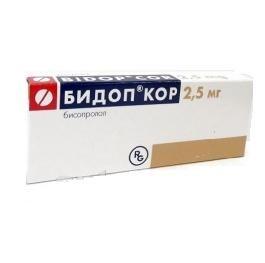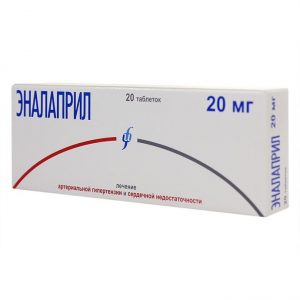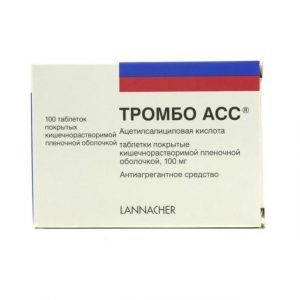Description
Release form
Tablets
Pharmacological action
Class III antiarrhythmic drug (repolarization inhibitor). It also has antianginal, coronary dilating, alpha and beta adreno blocking and antihypertensive effects.
Blocks inactive potassium (to a lesser extent, calcium and sodium) channels of the cell membranes of cardiomyocytes. By blocking inactivated “fast” sodium channels, it has effects characteristic of class I antiarrhythmic drugs. It inhibits the slow (diastolic) depolarization of the membrane of the cells of the sinus node, causing bradycardia, inhibits atrioventricular (AV) conduction (effect of class IV antiarrhythmics).
Has the properties of a non-competitive alpha and beta adreno receptor blocker.
The antiarrhythmic effect of amiodarone is associated with its ability to cause an increase in the duration of the action potential of cardiomyocytes and the effective refractory period of the atria and ventricles of the heart, AV node, His bundle, Purkinje fibers, which is accompanied by a decrease in the automatism of the sinus node, a slowdown in AV conduction, decreased excitability of cardiomyocytes.
Antianginal action is due to a decrease in myocardial oxygen demand due to a reduction in heart rate (HR) and a decrease in coronary artery resistance, which leads to an increase in coronary blood flow. It has no significant effect on systemic blood pressure (BP).
Similar in structure to thyroid hormones. The iodine content is about 37% of its molecular weight. It affects the metabolism of thyroid hormones, inhibits the conversion of thyroxine (T4) to triiodothyronine (TK) (blockade of thyroxin-5-deiodinase) and blocks the capture of these hormones by cardiocytes and hepatocytes, which leads to a weakening of the stimulating effect of thyroid hormones on the myocardium.
Onset of action (even with the use of “loading” doses) – from 2-3 days to 2-3 months, the duration of action varies from several weeks to months (determined in blood plasma for 9 months after stopping its use).
Pharmacokinetics
Absorption
After oral administration, it is slowly absorbed from the gastrointestinal tract, bioavailability is 35-65%. It is detected in the blood after 1 / 2-4 hours. The maximum concentration in the blood after taking a single dose is observed after 2-10 hours. The range of therapeutic plasma concentration is 1-2.5 mg / l (but when determining the dose, it is necessary to keep in mind the clinical picture) . The time to reach stationary concentration (TCss) is from one to several months (depending on individual characteristics).
Distribution
Distribution volume – 60 l, which indicates an intensive distribution in the tissues. It has high fat solubility, in high concentrations it is in adipose tissue and organs with good blood supply (concentration in adipose tissue, liver, kidneys, myocardium is higher than in blood plasma 300, 200, 50 and 34 times, respectively).
Pharmacokinetics of amiodarone necessitate the use of the drug in high loading doses. Penetrates through the blood-brain barrier and the placenta (10-50%), is secreted with breast milk (25% of the dose received by the mother). Communication with blood plasma proteins – 95% (62% – with albumin. 33.5% – with beta-lipoproteins).
Metabolism
Metabolized in the liver by the main metabolite – desethylamiodarone, which has similar pharmacological properties, can enhance the antiarrhythmic effect of the main compound. Maybe, it is also metabolized by deiodination (at a dose of 300 mg, approximately 9 mg of elemental iodine is released). With prolonged treatment, iodine concentrations can reach 60-80% of amiodarone concentration. It is a carrier of organic anions, an inhibitor of P-glycoprotein and isoenzymes CYP2C9, CYP2D6 and CYP3A4, CYP3A5, CYP3A7, CYP1AI, CYP1A2. CYP2C19, CYP2A6, CYP2B6, CYP2C8 in the liver.
Derivation of
Given the ability to cumulate and the associated large variability of pharmacokinetic parameters, the half-life data (T1 / 2) are inconsistent. The excretion of amiodarone after oral administration is carried out in 2 phases: the initial period is 4-21 hours, in the second phase T1 / 2 – 25-110 days (an average of 20-100 days). After prolonged oral administration, the average T1 / 2 is 40 days (this is important when choosing a dose, since it may be necessary at least 1 month to stabilize the new plasma concentration, while complete elimination may last more than 4 months).
It is excreted through the intestines – 85-95%, by the kidneys – less than 1% of the oral dose (therefore, with impaired renal function, there is no need to change the dosage). Amiodarone and its metabolites are not dialyzed.
Indications
Prevention of relapse
Life-threatening ventricular arrhythmias, including ventricular tachycardia and ventricular fibrillation (treatment should be started in a hospital with careful cardiac monitoring).
Supraventricular paroxysmal tachycardia: – documented episodes of recurrent sustained supraventricular paroxysmal tachycardia in patients with organic heart disease
– documented episodes of recurrent sustained supraventricular paroxysmal tachycardia when patients have other forms of heart disease – documented seizures of relapsing sustained supragastric paroxysmal tachycardia in patients with Wolff-Parkinson-White syndrome.
Atrial fibrillation (atrial fibrillation) and atrial flutter.
Prevention of sudden arrhythmic death in high-risk patients
Patients after a recent myocardial infarction with more than 10 ventricular extrasystoles in 1 hour, clinical manifestations of chronic heart failure and a reduced left ventricular ejection fraction (less than 40%).
Amiodarone can be used in the treatment of rhythm disturbances in patients with coronary heart disease and / or left ventricular dysfunction. Indications
Contraindications
Hypersensitivity to iodine, amiodarone, or excipients of the drug.
Lactose intolerance (lactase deficiency), glucose-galactose malabsorption syndrome (the drug contains lactose).
Sick sinus syndrome (sinus bradycardia, sinoatrial block), unless corrected by an artificial pacemaker (danger of “stopping” the sinus node).
Atrioventricular block II-III degree, in the absence of an artificial pacemaker (pacemaker).
Hypokalemia, hypomagnesemia.
Combination with drugs that can lengthen the QT interval and cause the development of paroxysmal tachycardia, including ventricular pirouette tachycardia (see section Interaction with other drugs ): – antiarrhythmic drugs: class IA (quinidine, hydroquinidine, dizopyramide, procainamide) class III antiarrhythmic drugs (dofetilide, ibutilide, bretilia tosylate) sotalol
– other (non-antiarrhythmic) drugs, such some antipsychotics as beprilide vincamine are: phenothiazines (chlorpromazine, cyamemazine, levomepromazine, thioridazine, trifluoperazin, flufenazine), benzamides (amisulpride, sulpride, sulpride, thiapride, veralipride), butyrophenone dol, pimozide cisapride tricyclic antidepressants macrolide antibiotics (including erythromycin when administered intravenously, spiramycin) azoles antimalarials (quinine, chloroquine, mefloquine, halofantrine) pentamidine with parenteral administration of diphemanil methyl sulfate misolastine astemizole, terfenadine fluoroquinolones.
Congenital or acquired lengthening of the QT interval.
Thyroid dysfunction (hypothyroidism, hyperthyroidism).
Interstitial lung disease.
Pregnancy (see. “Use during pregnancy and during lactation”).
Lactation (see “Use during pregnancy and lactation”).
Age under 18 (efficacy and safety not established).
Use during pregnancy and lactation
Amiodarone should not be used during pregnancy, since iodine begins to accumulate iodine during this period, and the use of amiodarone during this period can provoke the development of hypothyroidism due to an increase in iodine concentration. Use during pregnancy and lactation is only possible with life-threatening rhythm disturbances with the ineffectiveness of other antiarrhythmic therapy, since the drug causes dysfunction of the thyroid gland of the fetus.
Amiodarone crosses the placenta (10-50%), is secreted with breast milk (25% of the dose received by the mother), therefore the drug is contraindicated for use during lactation. If you need to use during lactation, then breast-feeding should be canceled.
Special instructions
Caution should be exercised when prescribing the drug to patients with heart failure, liver disease, hypokalemia, porphyria, elderly patients.
Before treatment and every 6 months during therapy, it is recommended to check thyroid function, the activity of liver transaminases and conduct an x-ray of the lungs and consultations with an ophthalmologist. Control ECGs must be taken every 3 months.
Please note that against the background of the use of Amiodarone, distortion of the results of determining the concentration of thyroid hormones (triiodothyronine, thyroxine, thyroid stimulating hormone) is possible.
With a heart rate below 55 beats / min, the drug must be temporarily discontinued.
When using Amiodarone, ECG changes are possible: lengthening of the QT interval with the possible appearance of a U wave. If atrioventricular block II and III degree, sinoatrial block, or blockade of the bundle of His appear, treatment with Amiodarone should be stopped immediately. With cancellation, relapse of heart rhythm disturbances is possible. After discontinuation of the drug, the pharmacodynamic effect persists for 10-30 days. Before surgery, as well as oxygen therapy, it is necessary to warn the doctor about the use of Amiodarone, since there have been rare cases of the development of acute respiratory distress syndrome in adult patients in the postoperative period.
To avoid the development of photosensitivity, patients should avoid sun exposure. Deposition of lipofuscin in the corneal epithelium decreases on its own when the dose is reduced or Amiodarone is withdrawn. Skin pigmentation decreases after discontinuation of the drug and gradually (within 1-4 years) completely disappears. After discontinuation of treatment, as a rule, spontaneous normalization of thyroid function is observed.
Information on the possible impact on the ability to drive vehicles, mechanisms
During the treatment period, you should refrain from driving and engaging in potentially hazardous activities, requiring increased concentration of attention and speed of psychomotor reactions.
Composition
1 tablet contains:
active ingredient – amiodarone hydrochloride 200 mg
excipients: lactose monohydrate, potato starch, povidone, calcium stearate.
Dosage and administration of
The drug should be taken only as directed by a doctor!
Amiodarone tablets are taken orally, before meals and
washed down with enough water.
Loading (saturating) dose of
Various saturation schemes may be used.
In the hospital, the initial dose, divided into several doses, ranges from 600-800 mg (up to a maximum of 1200 mg) per day until a total dose of 10 g is reached (usually within 5-8 days).
The ambulatory initial dose, divided into several doses, is from 600 to 800 mg per day until a total dose of 10 g is reached (usually within 10-14 days).
Maintenance dose may vary from 100 to 400 mg / day in different patients. The minimum effective dose should be applied in accordance with the individual therapeutic effect.
Since Amiodarone has a very long half-life, it can be taken every other day or take breaks in its intake 2 days a week.
The average therapeutic single dose is 200 mg.
The average therapeutic daily dose is 400 mg.
The maximum single dose is 400 mg.
The maximum daily dose is 1200 mg.
Side effects
Frequency: very often (10% or more), often (1% or more less than 10%), infrequently (0.1% or more less than 1%), rarely (0.01% or more less than 0 , 1%), very rarely (less than 0.01%, including individual cases), the frequency is unknown (according to the available data, it is not possible to determine the frequency).
From the cardiovascular system: often – moderate bradycardia (dose-dependent) infrequently – sinoatrial and atrioventricular blockade of various degrees, proarrhythmic effect is very rare – severe bradycardia, sinus node stop (in patients with sinus node dysfunction and elderly patients), the frequency is unknown – ventricle pirouette type tachycardia, progression of symptoms of chronic heart failure (with prolonged use).
From the digestive system: very often – nausea, vomiting, loss of appetite, dullness or loss of taste, a metallic taste in the mouth, a feeling of heaviness in the epigastrium, an isolated increase in the activity of liver transaminases, often – acute toxic hepatitis with an increase in the activity of liver transaminases and / or jaundice, including the development of liver failure is very rare – chronic liver failure.
From the respiratory system: often – interstitial or alveolar pneumonitis, obliterating bronchiolitis with pneumonia, pleurisy, pulmonary fibrosis is very rare – bronchospasm in patients with severe respiratory failure (especially in patients with bronchial asthma), acute respiratory syndrome frequency unknown – pulmonary hemorrhage.
From the side of the organ of vision: very often – microdeposition in the corneal epithelium, consisting of complex lipids, including lipofuscin (complaints of the appearance of a colored halo or blurred contours of objects in bright light) is very rare – optic neuritis / optic neuropathy.
From the side of metabolism: often – hypothyroidism, hyperthyroidism is very rare – syndrome of impaired secretion of antidiuretic hormone.
On the part of the skin: very often – photosensitization often – grayish or bluish skin pigmentation (with prolonged use), disappears after stopping the drug very rarely – erythema (with simultaneous radiation therapy), skin rash, exfoliative dermatitis (there is no connection with the drug established), alopecia is unknown frequency – urticaria.
From the side of the nervous system: often tremors and other extrapyramidal disorders, sleep disturbance infrequently – peripheral neuropathy and / or myopathy is very rare – cerebellar ataxia, benign intracranial hypertension, headache.
Other: frequency unknown – angioedema, formation of granulomas, including bone marrow granulomas, very rarely – vasculitis, epididymitis, impotence (no association with drug administration), thrombocytopenia, hemolytic and aplastic anemia.
If adverse reactions occur, discontinue use of the drug and consult a doctor.
If any of the side effects indicated in the instructions are aggravated or you notice any other side effects not listed in the instructions, inform your doctor.
Drug interaction
Contraindicated combinations: risk of developing polymorphic ventricular tachycardia of the pirouette type (arrhythmia characterized by polymorphic complexes that change the amplitude and direction of the excitation along the ventricles relative to the isoline (electrical systole of the heart): antiarrhythmic drugs of hydroxydinidine, class I dichinidine (x , procainamide), class III (dofetilide, ibutilide, bretilia tosylate), sotalol bepridil, vincamine, phenothiazines (chlorpromazine, cyamemazine, levomepromaz N, thioridazine, trifluoperazii, flufenasia), benzamides (amisulpride, sultopride, sulpiride, tiapride, veralipride), butyrophenones (droperidol, haloperidol), sertindole, pimozide tricyclic antidepressants, cisapride, macrolides (erythromycin against chlorin, medicines, spirals, , mefloquine, halofantrine, lumefantrine) pentamidine (parenteral), diphenyl methyl sulfate, misolastine, astemizole, terfenadine, fluoroquinolones (including moxifloxacin).
Not recommended combinations: beta-blockers, slow calcium channel blockers (verapamil, diltiazem) – the risk of impaired automatism (severe bradycardia) and conduction laxatives that stimulate intestinal motility, – the risk of developing ventricular tachycardia of the pirouette type against the background of hypokalemia, laxatives.
Combinations,hemia, amphotericin B (intravenously), systemic glucorticosteroids, tetracosactide – the risk of developing ventricular rhythm disturbances, including ventricular tachycardia of the pirouette type procainamide – the risk of side effects of procainamide (amiodarone increases the plasma concentration of procainamide and its metabolite, N-acetylprocainamide).
Indirect anticoagulants (warfarin) – amiodarone increases the concentration of warfarin (risk of bleeding) due to inhibition of the CYP2C9 isoenzyme cardiac glycosides – impaired automatism (severe bradycardia) and AV conduction (increased digoxin concentration).
Esmolol – a violation of contractility, automatism and conduction (suppression of compensatory reactions of the sympathetic nervous system). Phenytoin fosphenytoin – the risk of developing neurological disorders (amiodarone increases the concentration of phenytoin by inhibiting the isoenzyme CYP2C9).
Flecainide – amiodarone increases its concentration (due to inhibition of the CYP2D6 isoenzyme).
Drugs metabolized with the participation of the CYP3A4 isoenzyme (cyclosporine, fentanyl, lidocaine, tacrolimus, sildenafil, midazolam, triazolam, dihydroergotamine, ergotamine, inhibitors of HMG-CoA reductase inhibitors) – amiodarone increases their toxicity and pharmacokines when taking amiodarone with high doses of simvastatin increases the likelihood of developing myopathy).
Orlistat reduces the concentration of amiodarone and its active metabolite, clonidine, guanfacine, cholinesterase inhibitors (donepezil, galantamine, rivastigmine, tacrine, ambenonia chloride, pyridostigmine, neostigmine), pilocarpine – the risk of developing severe bradycardia.
Cimetidine, grapefruit juice slows down the metabolism of amiodarone and increases its plasma concentration.
Inhaled medications for general anesthesia – the risk of developing bradycardia (resistant to the administration of atropine), acute respiratory distress syndrome, including fatal, the development of which is associated with high oxygen concentrations, the risk of lowering blood pressure, cardiac output, conduction disturbance.
Radioactive iodine – amiodarone (contains iodine) may interfere with the absorption of radioactive iodine, which may distort the results of a radioisotope study of the thyroid gland.
Rifampicin and Hypericum perforatum (strong inducers of the isoenzyme CYP3A4) reduce the concentration of amiodarone in blood plasma. HIV protease inhibitors (inhibitors of the CYP3A4 isoenzyme) can increase plasma concentrations of amiodarone.
Photosensitizing drugs have an additive photosensitizing effect.
Clopidogrel – a decrease in its plasma concentration of dextromethorphan is possible (a substrate of the isoenzymes CYP3A4 and CYP2D6) – an increase in its concentration is possible (amiodarone inhibits the CYP2D6 isoenzyme). Dabigatran – an increase in its concentration in blood plasma with simultaneous use with amiodarone.
Overdose
Symptoms: bradycardia, AV block, ventricular tachycardia of the pirouette type, paroxysmal tachycardia of the pirouette type, aggravation of the symptoms of existing CHF, impaired liver function, cardiac arrest.
Treatment: gastric lavage, intake of activated charcoal, symptomatic therapy (for bradycardia – beta-adrenostimulants, atropine or installation of a pacemaker for tachycardia of the pirouette type – iv administration of magnesium salts, cardiac stimulation). Hemodialysis is ineffective.
Storage Conditions
In a dark place at a temperature not exceeding 25 ° C.
Keep out of the reach and sight of children.
Expiration
2 years.
active substance
amiodarone
Terms leave through pharmacies
In retseptu
Medicinal form
tablets
Indications
Indications
Arit myocardial aft




